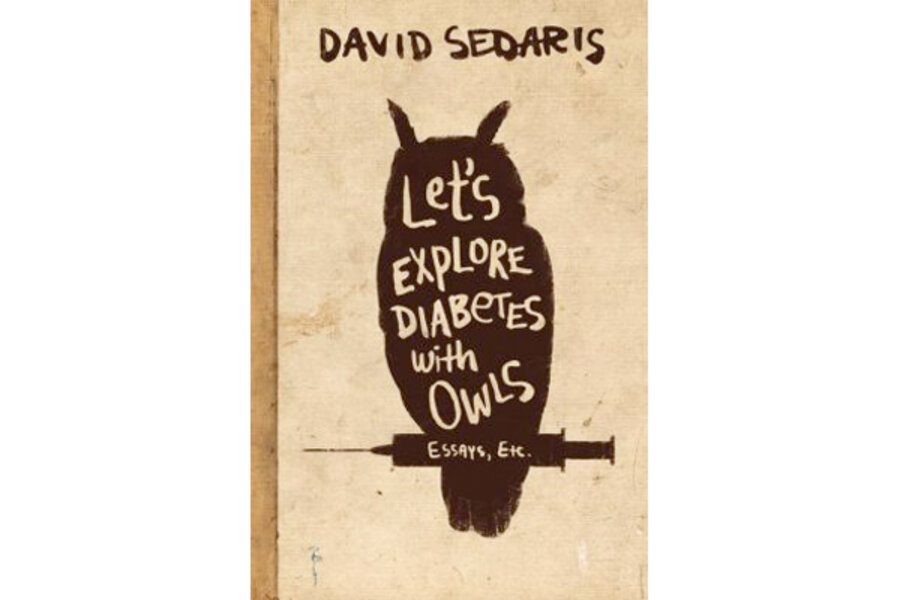Let's Talk Diabetes with Owls
Loading...
David Sedaris returns with a new collection of essays, Let’s Explore Diabetes with Owls. His topics, at this point, are familiar. There’s his family; his eminently tolerant boyfriend, Hugh; scenes from his feckless youth; and so on. If you’ve read Sedaris's past books, you know what’s coming.
Does that make it any less entertaining? Of course not. Sedaris remains as quick-witted as ever. Even in an essay in which he’s going after the low-hanging fruit of a basic language seminar, he’s still going to force you to interrupt whatever your friends and loved ones are doing to explain to them why you’re sitting there giggling.
If there is an issue with the language seminar essay (“Easy Tiger”), it may be in the sense that Sedaris is losing touch with the common man. This is a man who used to live in France and has since moved to the English countryside. The reason he’s taking the language seminars is that he’s traveling all over the world.
In one essay, he complains about being stuck in England for the summer because of a visa issue and it’s because he had his passport stolen in Hawaii. Neither of these things are going to inspire too much sympathy. He can still laugh at himself for having issues the rest of us should be so lucky to suffer through, but even so, he can occasionally seem a little out of touch.
The visa essay, “A Cold Case,” is the worst offender, but other essays, such as the one about traveling around near his place in the UK picking up litter (“Rubbish”), air similarly upper-class woes. He and Hugh decide to move to England, but Sedaris is shocked to learn that the English apparently have a bit of a litter problem. So he walks around picking up trash and feeling self-righteous about it.
The concept of the world-famous author walking around with grimy fingernails and picking up empty McDonald’s bags is comical on its own, but even within that context, it’s still an essay about a wealthy man with the time to go hike around the countryside all day. Earlier, Sedaris's distaste for the hygienic practices of the Chinese in “#2 to Go” never rises above easy jokes about the low dining standards he finds there. It’s funny, mostly, but did it need to be said? The notion that China is not as tidy as Western countries is not a new one. For one of the preeminent humorists of his day, it seems as if Sedaris could have – and should have – aimed a bit higher.
Other essays show a more reflective Sedaris. In “Standing Still,” he’s in his mid-20s, stuck in a dead-end job, in a cheap apartment, doing a lot of drugs, and not really attempting to aim for more in life. When his younger sister moves in to his apartment building, it briefly gives him a sense of purpose, because someone is looking up to him. When she’s nearly assaulted on the way home one night, the subsequent efforts he and his father make to find the attacker throw into sharp relief his own lack of prospects.
Once his sister doesn’t need him anymore, what does he have to offer? His inability to ask his father for help for himself is poignant and tragic, even though we know he did fine in the end.
Sedaris has also provided a series of comic monologues for use by students in forensics competitions. They’re satiric and sharp, but one might wonder if they are really appropriate for use in a high school competition. It’s some of the darkest material in the book, taking as topics the likely horrors of legalizing gay marriage and a teenage girl infatuated with British slang. Much of that slang is not exactly printable.
Still, even a slightly complacent Sedaris is worth reading. No matter how successful he is, he’s always going to be a slightly weird guy, the sort of man who wants a realistic model of the human throat for Valentine’s Day and in return hunts down a taxidermied owl for Hugh. Such adventures, rendered in Sedaris’s characteristic matter-of-fact tone, will always be entertaining. His tendency to relate the strangest things he thinks as though they’re perfectly normal remains a strength. While Sedaris might no longer be quite the same man we met through such classics as “Me Talk Pretty One Day” and “Naked,” he’s still great company.
Lisa Weidenfeld is a Monitor contributor.








